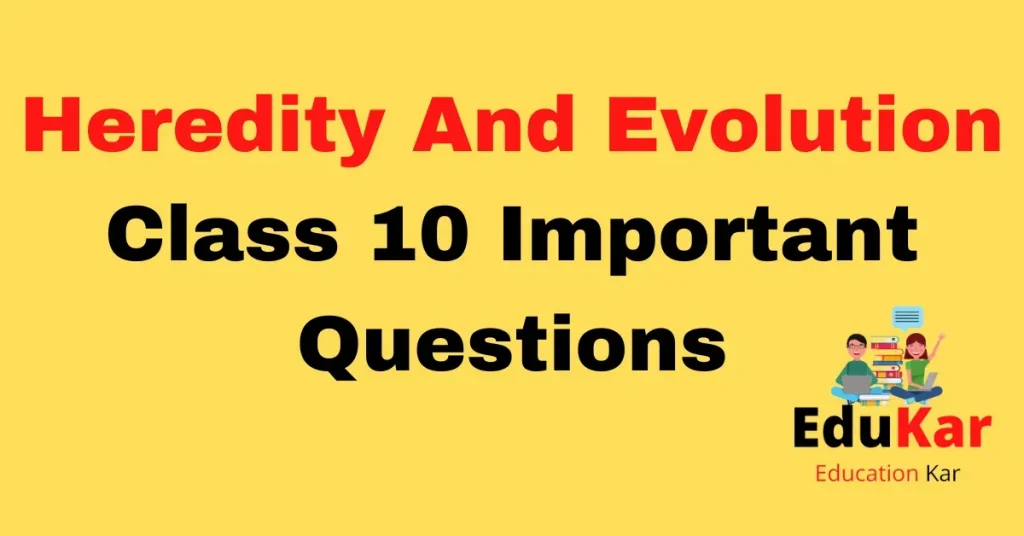
Q1. All the variations in an exceedingly species don’t have equal chances of survival. Why so? (Foreign 2014)
ANS. All the variations don’t have equal chances of survival within the environment during which they live. Depending on the nature of variations, different individuals would have different kinds of benefits. The organisms which are most adapted to the surrounding will survive.
Q2. ‘Only difference that confer a bonus to an individual organism will survive in a population.’ Justify this Statement. (Foreign 2011)
ANS. Variations are the functional, structural, or behavioral changes from the traditional characters developed in the living organisms. Inheritable variations participate within evolution. In line with Darwin, natural selection sorts out individuals with favorable variation. Such organisms will survive, reproduce more & thus, will leave more progenies. Hence, useful variations get established in surrounding-nature.
Q3. A Mendelian experiment contains of breeding pea plants bearing violet flowers with pea plants bearing white flowers. What’s going to be the result in F1 progeny? (2018)
ANS. In step with the Mendelian experiment, violet color (VV) is a dominant trait whereas, white color (ww) is a recessive trait. Hence, the color of the flower in F1 progeny are violet (Vw).
Q4. Name the information source for creating proteins within the cells. (Delhi 2014)
ANS. Deoxyribonucleic acid (DNA) present within the chromosomes of cell nucleus is that the information source for creating proteins.
Q5. What’s a Gene? (AI 2014)
ANS. A gene is a unit of DNA on a chromosome which commands the synthesis of particular protein that controls specific characteristics (or traits) of an organism.
Q6. What’s Heredity? (AI 2014)
ANS. The inheritance of characters (or trails) from the oldsters to their offsprings is known as heredity.
Q7. Why is that the progeny always tall when a tall legume is crossed with a short pea plant? (Foreign 2014)
ANS. When a tall legume is crossed with a short pea plant, the resultant progeny is usually tall because tall is dominant trait & short is recessive trait. Therefore, dominant trait expresses itself within the progeny.
Q8. Write the contribution of Charles Darwin within the field of evolution. (Delhi 2014)
ANS. ‘Lhe contribution of Darwin in the field of evolution is that only the organism which may or can adapt; to the changing environmental conditions can survive & he also stated that the natural selection is a process which plays an crucial role in evolution of plants & animals by selecting the organisms with traits favorable to the surrounding.
Q9. What’s a Monohybrid Cross?
Ans: The combination between 2 plants that shows two different variants of a property (character).
Q10. What are autosomes & sex chromosomes?
Ans: There are total 23 pairs of Chromosomes in a Human Cell. 22 pairs are named autosomes, while the left 1 pair, which decide a child’s sex, is known as sex chromosome.
Q11. Who coined the expression ‘gene’?
Ans: The word gene was originated by Johannsen (1909).
Q12. What are Dominant Genes?
Ans: A Dominant Gene is one who expresses itself.
Q13. Write the binomial name of the plant on which Mendel carried out his experiments.
Ans: It’s Pisum Sativum
Q14. How many autosomes are their in human sperm?
Ans: It’s 22
Q15. Who is known as the father of genetics?
Ans: Gregor Mendel.
Q16. What’s the binomen name of a human being?
Ans: It’s Homo Sapiens
Q17. What’s Heredity?
Ans: Heredity point-out to the transmission of a person’s personality from one generation to the next generation.
Q18. What’s Mendelian Factors?
Ans: Mendelian factors are heredity parts that carry on a nature from parents to offspring.
Q19. What happened when Mendel crossed 2 traits of a disposition in a pea plant?
Ans: Mendel discovered that each characteristic was inherited separately from the others, resulting in it’s own 3:1 ratio.
Q20. Who apportioned experimental evidence to assist the theory of the origin of life from inanimate matter?
Ans: Miller & Urey
Q21. A normal pea plant bearing colored flowers immediately starts producing white flowers. What could be the feasible cause?
Ans: Mutation is behind for the appearance of white flowers.
Q22. Bring up any 2 recessive traits of a garden pea.
Ans: Dwarf (height of plant) & Wrinkled Seed.
Q23. What is called a Phylogenetic System of classification?
Ans: Organisms can be sorted depending on their evolutionary relations.
Q24. What can be the percentage of ab gametes produced by AaBb parents?
Ans: It’s 25%
Q25. Mendel crossed a pure colorless recessive pea plant with a dominant pure red color flowered plant. What can be the first-generation f hybrids.?
Ans: It’s Allred
Q26. Name the chemicals which are important for the origin of life.
Ans: It’s Proteins & nucleic acid
Q27. Why are males known as Heterogametic?
Ans: Males are known as Heterogametic because their ‘Y chromosomes’ are different.
Q28. What is the % possibility of a couple having daughters?
Ans: It’s 50 %.
Q29. Name two organisms in which sex determination is regulated by surrounding factors.
Ans: It’s Turtle & lizard.
Q30. Clones of sheep are carbon copies of each other excluding for physical health. What type of variation is it?
Ans: It is a ‘Phenotypic’ variation.
Q31. Why are obtained traits not inherited?
Ans: Acquired traits are those that organisms grow over the course of their lives. These typically cannot be handed down because they’re caused by non-reproductive tissue.
Q32. What’s Coacervates?
Ans: Coacervates are the first life molecules generated when a membrane forms around amino acids, sugars, & nitrogenous bases aggregates. Coacervates continue to develop, eventually leading to the origin of life.
Q33. How do the 2 factors for a character, present in Diploid cells, act at the time of Gamete formation?
Ans: During gamete development, 2 components named ‘X’ & ‘Y’ separate. As a conclusion, the gamete can be ‘X’ or ‘Y’.
Q34. Bring-up 2 main features of fossils that help in evolution.
Ans: The 2 main features of fossils that help in evolution:
(i) Fossils are a kind of ancient species preservation.
(ii) Fossils aid in the spotting of evolutionary relationships between creatures & their forefathers & mothers.
Q35. What do you realize by the word natural selection?
Ans: Natural selection theory says that nature selects the healthiest animals for breeding, while those who do not fit are taken out by nature.
Q36. Bring-up the complement of a sperm & the egg which will determine the birth of a female child.
Ans: The ‘X’ chromosome is found in both the egg & the sperm of a female child and it’s the complement of a egg & the sperm which will direct the birth of a Female Child.
Q37. What’s emasculation and why is it done?
Ans: Emasculation is the moving of an anther to prevent pollination in an experimental plant.
Q38. What’s a gene? Where are genes found?
Ans: The word ‘gene’ refers to DNA segments.
Chromosomes are where genes are situated.
Q39. How many contrasting nature did Mendel see in garden pea? Give any 2 of them.
Ans: In the pea plant, Mendel found seven distinct characteristics.
For ex- axial & terminal flower positions. Round & wrinkled seed form.
Q40. Why are acquired nature not inherited?
Ans: Acquired qualities are those that living thing develop over the course of their lives.
They are not passed down to upcoming future generations. Because these usually are caused by non-reproductive tissues, as they cannot be handed forward.
Q41. How is the chromosome number reinstate in the zygote?
Ans: Female & Male gametes each have ‘N’ chromosomes. Gametes merge & form a zygote during fertilization and the no. of chromosomes present in Zygote is ‘2N.’
Q42. What will be the sex of the embryo if an egg is pollinate by the sperm having?
(a) 22+y22+y Composition
Ans: Male.
(b) 22+x22+x
Ans: Female
Q43. Bring-up 2 sources of variation.
Ans: 2 sources of variation are:-
- DNA copying errors.
- Fertilization at random.
Q44. What are monohybrid & dihybrid cross? Give one exemplar of each.
Ans: Dihybrid cross- A dihybrid cross is a cross between 2 plants with two sets of opposing nature. Round & green seed, for ex- crossed with yellow & wrinkled seed.
Monohybrid cross- This is the simple cross in which only 1 nature’s inheritance is investigated. A cross is made by crossing 2 plants with one contrasting usually, like tall or dwarf.
Q45. Can the wing of a butterfly & the wing of the bat be advised homologous organs?
Ans: No, while the purpose of the wing is same in both cases, the structural plan & origin are not.
Q46. Explain the significance of fossils in deciding evolutionary relationships.
Ans: The significance of fossils in deciding evolutionary relationships are:
- Knowing the age of fossils allows us to decide which being evolved first & which evolved later.
- The study of fossils allows us to roughly calculate how far back creatures evolutionary correlation go.
Q47. Why are the less no. of current tigers a cause of worry from the point of view of genetics?
Ans: As the tiger population lowering, genes are off-course from the gene pool, which indicates there can be no recombination or alternative, & hence no evolution.
Q48. How one is adopted to perform different tasks? Give 1 example.
Ans: One modification that took place early in evolution is now utilised to accomplish additional tasks. Feathers, for ex- Evolved for warmth before being changed for flying.
Q49. Why are asexually reproducing organisms have the ability to show hereditary features?
Ans: Asexual reproduction manage to preserve the genetic likeness among all members of a line of descent. As a result, asexually reproducing organisms can exhibit hereditary habituality.
Q50. What’s offspring?
Ans: Offspring are beings that are grow as a result of gene segment crossing & exchange in sexual reproduction.







